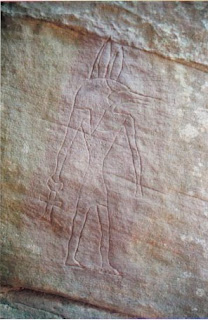Have chisel will chip!
Before recoiling in absolute incredulity that, deep in antiquity, oceangoing mariners from ancient Egypt landed on Australian shores, the evidence unearthed by Michael Terry, the veteran explorer of the Australian interior, should be investigated.
In 1961, on a mining exploration west of Alice Springs, near the Western Australian border, he spotted a carving of a rhinoceros-type animal, with short stumpy legs, a long upswept tail, and a curved back and horn. A short distance away, further search “revealed a horizontal human figure about seven feet long on a cliff face. . . . It seemed to have some kind of headdress, or helmet. There was a proper outline of anatomy. Whereas Aborigines are content to represent legs and arms by straight lines, this figure possessed ankles, calves, thighs and so on” (“Did Ptolemy Know of Australia?” Walkabout, August 1965). Six examples of a “ram’s head” symbol were also found nearby. Both the “rhinoceros” and the horizontal figure were 30 feet above the present ground level, suggesting that the platform used by the carver had eroded away, testifying to their great age. Intrigued by this discovery, Terry embarked on further research into the whole question of pre-16th-century sightings and even landings on the southern continent. He reported that in 1891, Joseph Bradshaw found rock paintings in a cave near the Prince Regent River in Western Australia and quoted him as stating: “the most remarkable fact is that wherever a profile face in shown the features are of a most pronounced aquiline type, quite different from those of the natives we encountered. One might imagine himself viewing the painted walls of an ancient Egyptian temple.”
Terry also documents the finding of a 2,200-year-old coin of Pharaoh Ptolemy IV (221–204 B.C.) by Andy Henderson in 1910, discovered while he was sinking a line of post holes across an Aboriginal track. The coin was two feet below the surface of a gravel ridge in a rain forest, inland from Taylor’s Bay, 10 miles north of Cairns, a location that positively invites enticing speculation because the bay “is an obvious shelter from the south-east monsoon. I hazard that ancient mariners anchored there, and that some of the crew went ashore to explore the tableland, by way of the sole access, the Aboriginal walking-track. Possibly one carried a bag of coins which broke, or in some other way dropped the coin that Henderson retrieved” (“Australia’s Unwritten History.” Walkabout, August 1967).
Of course, it is always pleasant and diverting to indulge in flights of fancy but the impartial observer might conclude that Terry offers a sufficient core of hard facts to warrant further academic research.

0 comments:
Post a Comment